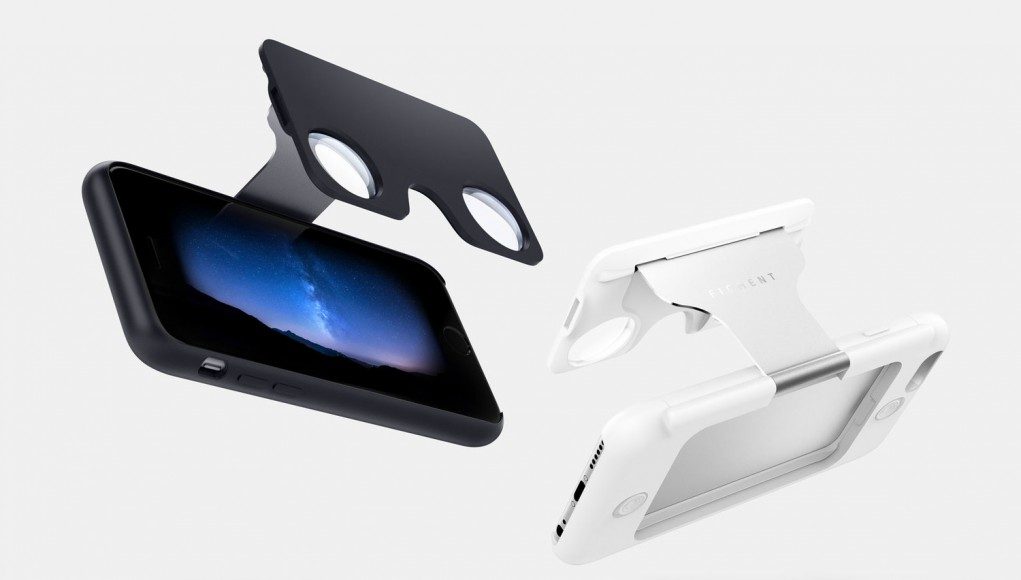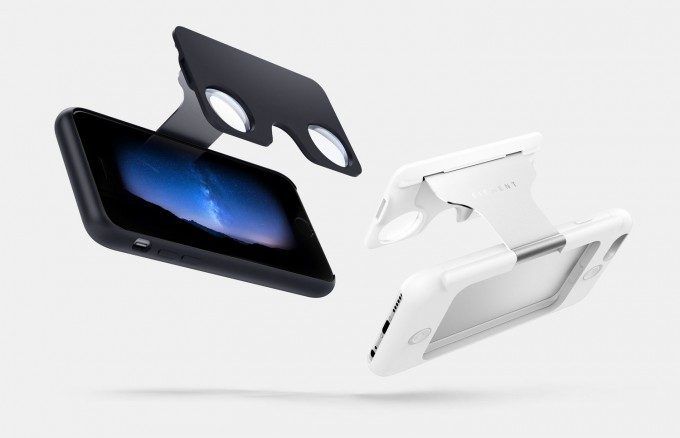For ‘causal’ virtual reality to take off—the kind that you and I can create and share as easily as we do with photos today—it needs to be accessible. Google Cardboard has made important strides in introducing people to the low end of the immersive spectrum, but there’s still a lot of friction in the user experience, on both the software and hardware ends. Figment VR aims to fix the latter.
This isn’t the first smartphone VR case we’ve seen, but it may be the smartest yet. Figment VR‘s iPhone case has a dead simple approach to providing quick and painless access to mobile VR content. The design features a spring-loaded mechanism that stows flat against the back of the case and pops out when needed, providing two simple lenses for a Cardboard-level immersive experience. The action literally takes seconds, and if it all works as easy as they make it look, it’ll ultimately lower friction needed to use VR, making casual usage ever more appealing.
For ‘causal’ virtual reality to take off—the kind that you and I can create and share as easily as we do with photos today—it needs to be accessible. Google Cardboard has made important strides in introducing people to the low end of the immersive spectrum, but there’s still a lot of friction in the user experience, on both the software and hardware ends. Figment VR aims to fix the latter.
This isn’t the first smartphone VR case we’ve seen, but it may be the smartest yet. Figment VR‘s iPhone case has a dead simple approach to providing quick and painless access to mobile VR content. The design features a spring-loaded mechanism that stows flat against the back of the case and pops out when needed, providing two simple lenses for a Cardboard-level immersive experience. The action literally takes seconds, and if it all works as easy as they make it look, it’ll ultimately lower friction needed to use VR, making casual usage ever more appealing.
The company has taken to Kickstarter to raise $75,000 for the production of the device.
Less friction means more usage. Take, for example, the act of looking at some photos posted to Facebook by a friend. You can do this in a matter of seconds from nearly anywhere with your smartphone. Pull it out, tap tap, swipe swipe, done. It’s so easy you can do it on the bus, you can do it standing in line at the grocery store, you can even do it on the toilet.
Now imagine just a few years back. The technology to achieve the same thing existed, but with far more friction. Using something like a Sony Vaio UX, you could pull the bulky package out of your cargo pocket, awake the unit from sleep in about 10 seconds, connect the inbuilt EDGE modem for data connectivity, then navigate to the Facebook.com desktop page and sift through your friend’s photos at 400 kbit/s. But you wouldn’t do that because the reward of seeing those photos doesn’t justify the effort.
And yet, that feels much like where we are today with mobile VR: carry around a dedicated piece of equipment that hopefully fits into another one of your pockets. Want to view some VR content? Get out your phone and your viewer, merge the two together, and then take a look inside. When you’re done, pull it all apart to get back to your usual smartphone browsing. You might do this if there’s an exciting video of reasonable length for you to watch, but you probably wouldn’t do it to look at some immersive photos.
That’s where a solution as simple at Figment’s makes all the difference. As soon as youmake the action of viewing VR content frictionless, you open the door to so many more content possibilities. Suddenly it’s practical to pop the lenses out and take a 10 second look at an immersive photo, or a 1 minute immersive video your friend shot from the top of Mt. Rainier, then easily switch back to using your smartphone as you normally do.
The Figment VR smartphone case is unfortunately only available for the iPhone 6/6S and iPhone 6/6S Plus, though the creators say they’ll expand to Android and Windows phone devices if their campaign is successful. It’s a curious choice to aim at the iPhone first because Android has a head start on iOS when it comes to VR content, but Google Cardboard is making strides in Apple’s App Store.








